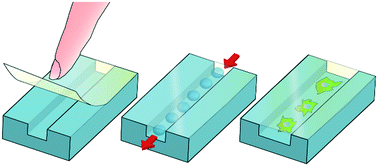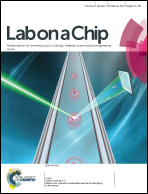A simple and low-cost chip bonding solution for high pressure, high temperature and biological applications†
Abstract
The sealing of microfluidic devices remains a complex and time-consuming process requiring specific equipment and protocols: a universal method is thus highly desirable. We propose here the use of a commercially available sealing tape as a robust, versatile, reversible solution, compatible with cell and molecular biology protocols, and requiring only the application of manually achievable pressures. The performance of the seal was tested with regards to the most commonly used chip materials. For most materials, the bonding resisted 5 bars at room temperature and 1 bar at 95 °C. This method should find numerous uses, ranging from fast prototyping in the laboratory to implementation in low technology environments or industrial production.

- This article is part of the themed collection: Lab on a Chip Recent Open Access Articles


 Please wait while we load your content...
Please wait while we load your content...